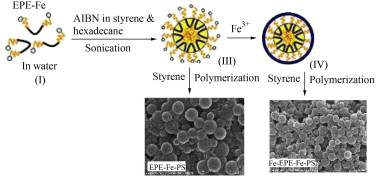1 Fendler, J. H. Membrane Mimetic Chemistry, Wiley-Inter-science, New York, 1982.2 Koblenz, T. S.; Wassenaar, J.; Reek, J. N. H. Chem. Soc. Rev. 2008, 37, 247.  3 Fendler, J. H.; Fendler, E. J. Catalysis in Micellar and Macromolecular Systems, Academic Press, London, 1975.4 Vriezema, D. M.; Aragonès, M. C.; Elemans, J. A. A. W.; Cornelissen, J. J. L. M.; Rowan, A. E.; Nolte, R. J. M. Chem. Rev. 2005, 105, 1445. 3 Fendler, J. H.; Fendler, E. J. Catalysis in Micellar and Macromolecular Systems, Academic Press, London, 1975.4 Vriezema, D. M.; Aragonès, M. C.; Elemans, J. A. A. W.; Cornelissen, J. J. L. M.; Rowan, A. E.; Nolte, R. J. M. Chem. Rev. 2005, 105, 1445.  5 Rabion, A.; Buchanan, R. M.; Fish, R. H. J. Mol. Catal. A: Chem. 1997, 116, 43. 5 Rabion, A.; Buchanan, R. M.; Fish, R. H. J. Mol. Catal. A: Chem. 1997, 116, 43.  6 Fuji, K.; Morlmote, T.; Kakiuchi, K. Angew. Chem., Int. Ed. Engl. 2003, 42, 2409. 6 Fuji, K.; Morlmote, T.; Kakiuchi, K. Angew. Chem., Int. Ed. Engl. 2003, 42, 2409.  7 Benjamin, M.; Rossbach, K. L.; Weberskirch, R. Angew. Chem., Int. Ed. Engl. 2006, 45, 1309. 7 Benjamin, M.; Rossbach, K. L.; Weberskirch, R. Angew. Chem., Int. Ed. Engl. 2006, 45, 1309.  8 Liang, G.; Xu, J. Wang, X. J. Am. Chem. Soc. 2009, 131,5378. 8 Liang, G.; Xu, J. Wang, X. J. Am. Chem. Soc. 2009, 131,5378.  9 Bouilhac, C.; Cloutet, E.; Taton, D,; Deffieux, A. ; Borsali, R.; Cramail, H. J. Polym. Sci., Part A: Polym. Chem. 2009,47, 197. 9 Bouilhac, C.; Cloutet, E.; Taton, D,; Deffieux, A. ; Borsali, R.; Cramail, H. J. Polym. Sci., Part A: Polym. Chem. 2009,47, 197.  10 John, U.; Preben, M. Polym. Int. 1993, 30, 157. 10 John, U.; Preben, M. Polym. Int. 1993, 30, 157.  11 Chen, S.-L.; Dong, P.; Yuan, G.-M. J. Wuhan Univ. Technol.2007, 29, 96 (in Chinese). (陈胜利, 董鹏, 袁桂梅, 武汉理工大学学报, 2007, 29,96.)12 Huang, L.-Y.; Zhang, Y.; Liu, Z.-P.; Niu, J.-F. J. Beijing Normal Univ. 2006, (3), 177 (in Chinese). (黄俐研, 张艳, 刘正平, 牛静芳, 北京师范大学学报(自 然科学版), 2006, (3), 177.) 11 Chen, S.-L.; Dong, P.; Yuan, G.-M. J. Wuhan Univ. Technol.2007, 29, 96 (in Chinese). (陈胜利, 董鹏, 袁桂梅, 武汉理工大学学报, 2007, 29,96.)12 Huang, L.-Y.; Zhang, Y.; Liu, Z.-P.; Niu, J.-F. J. Beijing Normal Univ. 2006, (3), 177 (in Chinese). (黄俐研, 张艳, 刘正平, 牛静芳, 北京师范大学学报(自 然科学版), 2006, (3), 177.)  13 Zhou, X.-Y.; Zhang, G.-H. Plastics 2008, 37, 37 (in Chinese). (周晓英, 张光华, 塑料, 2008, 37, 37.)14 Song, J. H.; Kretzschmar, I. ACS Appl. Mater. Interfaces2009, 1, 1747. 13 Zhou, X.-Y.; Zhang, G.-H. Plastics 2008, 37, 37 (in Chinese). (周晓英, 张光华, 塑料, 2008, 37, 37.)14 Song, J. H.; Kretzschmar, I. ACS Appl. Mater. Interfaces2009, 1, 1747.  15 Budijono, S. J.; Russ, B.; Saad, W.; Adamson, D. H.; Prudhomme, R. K. Colloids Surf. A: Physicochem. Eng. Aspects2010, 360, 105. 15 Budijono, S. J.; Russ, B.; Saad, W.; Adamson, D. H.; Prudhomme, R. K. Colloids Surf. A: Physicochem. Eng. Aspects2010, 360, 105.  16 Mallik, A. K.; Sawada, T.; Takafuji, M.; Ihara, M. Anal. Chem. 2010, 82, 3320. 16 Mallik, A. K.; Sawada, T.; Takafuji, M.; Ihara, M. Anal. Chem. 2010, 82, 3320.  17 Du, X.; Liu, X.-M.; Zheng, Y.; He, J.-H. Acta Chim. Sinica2009, 67, 435 (in Chinese). (杜鑫, 刘湘梅, 郑奕, 贺军辉, 化学学报, 2009, 67, 435.)18 Deng, W.; Chen, G.; Jia, L.; Wang, M.; Gong, L.; Kan, C. Acta Chim. Sinica 2010, 68, 2000 (in Chinese). (邓伟, 陈国, 贾连昆, 王满意, 宫理想, 阚成友, 化学学 报, 2010, 68, 2000.)19 McIntyre, D.; Fetters, L. J.; Slagowski, E. P. Science 1972,176, 1041. 17 Du, X.; Liu, X.-M.; Zheng, Y.; He, J.-H. Acta Chim. Sinica2009, 67, 435 (in Chinese). (杜鑫, 刘湘梅, 郑奕, 贺军辉, 化学学报, 2009, 67, 435.)18 Deng, W.; Chen, G.; Jia, L.; Wang, M.; Gong, L.; Kan, C. Acta Chim. Sinica 2010, 68, 2000 (in Chinese). (邓伟, 陈国, 贾连昆, 王满意, 宫理想, 阚成友, 化学学 报, 2010, 68, 2000.)19 McIntyre, D.; Fetters, L. J.; Slagowski, E. P. Science 1972,176, 1041.  20 Mueller, L.; Jakubowski, W.; Matyjaszewski, K.; Pietrasik, J.; Kwiatkowski, P.; Chaladaj, W.; Jurczak, J. Eur. Polym. J.2011, 47, 730.21 Kwiatkowski, P.; Jurczak, J.; Pietrasik, J.; Jakubowski, W.; Mueller, L.; Matyjaszewski, K. Macromolecules 2008, 41,1067. 20 Mueller, L.; Jakubowski, W.; Matyjaszewski, K.; Pietrasik, J.; Kwiatkowski, P.; Chaladaj, W.; Jurczak, J. Eur. Polym. J.2011, 47, 730.21 Kwiatkowski, P.; Jurczak, J.; Pietrasik, J.; Jakubowski, W.; Mueller, L.; Matyjaszewski, K. Macromolecules 2008, 41,1067.  22 Tundo, P.; Anastas, P.; Black, D. S.; Breen, J.; Collins, T.; Memoli, S.; Miyamoto, J.; Polyakoff, M.; Tumas, W. Pure Appl. Chem. 2000, 72, 1207. 22 Tundo, P.; Anastas, P.; Black, D. S.; Breen, J.; Collins, T.; Memoli, S.; Miyamoto, J.; Polyakoff, M.; Tumas, W. Pure Appl. Chem. 2000, 72, 1207.  23 Manabe, K.; Iimura, S.; Sun, X.-M.; Kobayashi, S. J. Am. Chem. Soc. 2002, 123, 10101. 23 Manabe, K.; Iimura, S.; Sun, X.-M.; Kobayashi, S. J. Am. Chem. Soc. 2002, 123, 10101. |
